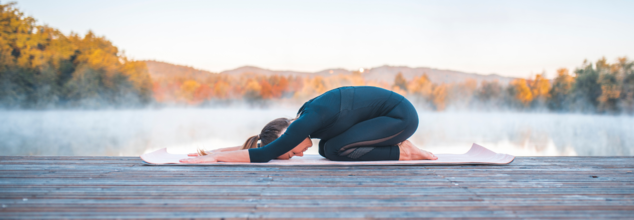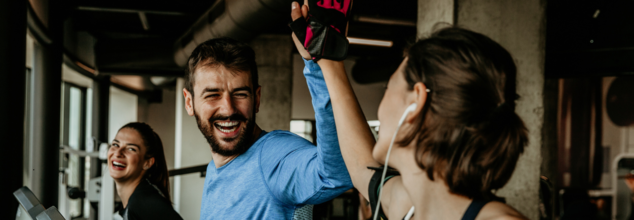- Health Conditions A-Z
- Health & Wellness
- Nutrition
- Fitness
- Health News
- Ayurveda
- Videos
- Medicine A-Z
- Parenting
- Web Stories
Can Yoga Help Make Your Lung Stronger?

(Credit-Canva)
Yoga plays a very important role for our health- It not only helps us strengthen our body, but it also increases our endurance and mental tenacity. It is an ancient practice that involves asanas, breathing exercises as well as meditation. It has become very popular in recent years as people learn about its accessibility as well as the benefits of doing it. Other aspects of yoga include increasing organ capacity like strengthening your lungs.
How Yoga Increases Lung Capacity
A 2015 study published in the International Journal of Yoga people with heart conditions like coronary artery disease (CAD) often have weaker lungs. We did a study to see if yoga, including breathing exercises (Pranayama), could help. We split 80 heart patients into two groups: one did yoga for three months along with their usual medicine, and the other just took medicine.
The results showed that the yoga group had better lung function and even improved heart health, like lower blood pressure. This means yoga can be a helpful extra treatment for people with heart disease.
According to the American Lung Association, Yoga is a great gentle exercise that combines physical poses (called asana) with breathing exercises (called pranayama). Both parts help keep your body and mind healthy.
Doing basic yoga poses can boost your energy and strengthen muscles, but don't push yourself if it feels uncomfortable. If you're new to yoga, especially if you have lung disease, take it easy and avoid any poses that make it hard to breathe. Always check with your doctor before starting any new exercise, including yoga. If you join a yoga class, make sure the teacher is qualified and understands your specific needs. Many classes are designed for people with health conditions.
Yoga Poses That Strengthen Our Lungs
Cobra Pose (Bhujangasana)
This gentle pose involves arching your back like a cobra. It helps to open up your chest and makes your spine stronger. By expanding your rib cage, it allows you to take deeper breaths, which is great for your lungs.
Bow Pose (Dhanurasana)
In this pose, you lift both your chest and legs like a bow. It deeply stretches the front of your body, including your chest and belly. This helps your lungs become more flexible and can make breathing easier if you have issues.
Camel Pose (Ustrasana)
This pose involves arching your back and reaching for your heels. It strongly opens your chest and throat area, which gets your breathing system going. It encourages full, big breaths and can help clear out your air passages.
Half Lord of the Fishes Pose
This is a seated twisting pose. It gently squeezes and then releases your insides, which helps blood flow around your lungs. This pose can improve how well you control your breath and helps to clean out your breathing system.
Pranayama
This isn't just one pose, but a group of special breathing exercises. Techniques like breathing through one nostril at a time or taking deep belly breaths directly improve how your lungs work, helping you take in more oxygen and feel calmer.
Revolved Side Angle Pose
This standing twist stretches the muscles between your ribs. This makes your chest more flexible, allowing for deeper breaths when you inhale. It's a great way to improve your lung capacity and make breathing more efficient.
Bridge Pose (Setu Bandhasana)
In this pose, you lift your hips off the ground, forming a bridge shape. It gently opens your chest and stretches the front of your body. This pose can help ease chest stuffiness and make it simpler to breathe.
What Is Japanese Walk—The Fitness Trend That Makes You 10 Years Younger

Credit: Canva
Walking is the simplest form of exercise. While it is something that we are genetically designed to do, there has been debate on its efficiency as a full-fledged form of exercise. In the latest development, scientists in Japan have taken this activity and supercharged it into a research-backed, age-defying fitness routine that's going viral across the world. Called Interval Walking Training (IWT), its health benefits have not stunned even the most dedicated gym goers.
So What Exactly IS Interval Walking Training?
Developed by exercise physiologist Dr. Hiroshi Nose, this method alternates between three minutes of brisk walking and three minutes of easy pacing, repeated five times in a 30-minute session. As per its creators, it is all about small bursts of energy. The results? A fitter heart, stronger legs, and even a shot at turning back the biological clock.
How Is It Different From Regular Walking?
Most people associate High-Intensity Interval Training (HIIT) with gruelling sprints or gasping for air on a spin bike. But IWT flips the idea by using something as accessible as walking. And yet, this deceptively gentle routine does more for your metabolism, cardiovascular health, and fat burn than hours of slow-paced activity.
The technique has a empirical backing too. Scientific trials in Japan have shown that those who practised this method four times a week for three months saw measurable improvements in cholesterol, blood pressure, blood sugar levels, and even muscle strength. One 68-year-old participant had his heart rate shoot up to 130 bpm during the fast intervals — a pace comparable to moderate cycling.
Can It Reverse Ageing?
The creator of this walking method, Dr. Nose, even claims that consistent IWT participants improved their aerobic power and thigh muscle strength by 20% — enough to make you feel ten years younger. For many, symptoms of lifestyle diseases like hypertension and obesity dropped significantly, and depression scores were halved.
Why Does Japanese Walking Work So Well?
It is all in the timing and intensity. During fast-paced intervals, your body taps into glycogen stores and increases oxygen demand, triggering a cascade of metabolic benefits. The alternation between effort and recovery mimics the rhythm of elite athlete training, just with lower impact, making it ideal for seniors, beginners, or anyone recovering from a sedentary slump.
This burst-and-breathe pattern revs up your heart rate, challenges muscle coordination, and improves balance, especially in older adults. The circulation boost helps detoxify organs, enhance nutrient absorption, and sharpen mental clarity, making it not just a physical workout but a rejuvenating full-body experience.
Variations For Every Lifestyle
Want to take it up a notch? Add light weights to your walk to tone muscles and increase calorie burn. Want to spice things up indoors? Try zig-zag paths, backwards walks, or figure-8 routes to engage underused muscles and keep your mind focused. These patterns not only improve neuromuscular coordination but also keep boredom at bay. So the next time you’re thinking of skipping your workout, remember: A smarter walk could be your shortcut to a longer, stronger, and more balanced life.
Grounding Yoga Poses That Can Help You Wind Down After A Long Day

(Credit-Canva)
Yoga is a great way to wind down and relax. While exercising after a long day may seem counterproductive, there are many other reasons why one should do yoga if they are tired and overwhelmed. There are certain poses and movements that help you find your rhythm, revitalizing you and helping your body calm down and relax. Practicing this before ending your day can help you get a restful sleep, instead of the hurried and uncomfortable sleep you get when you crash out.
These grounding practices can be incredibly soothing for the nervous system, helping to shift you from that 'fight or flight' mode into a state of calm and rest. They are comforting for your mind and body, preparing you for a peaceful evening and a restful night. So, if you're feeling wired but tired, these grounding yoga poses are your invitation to unwind, find your center, and let go of the day's stresses.
Child's Pose (Bālāsana)
Gently rest your forehead on the mat with your knees wide or together, and arms stretched forward or alongside your body. This pose calms the brain and helps relieve stress and fatigue. It's like a gentle hug for your insides.
Legs-Up-the-Wall Pose (Viparita Karani)
Simply lie on your back and prop your legs up against a wall or chair. This inversion helps to drain stagnant energy from your legs and feet, promoting relaxation and easing tired legs. It can also soothe the nervous system.
Supported Bridge Pose (Setu Bandhāsana Variation)
Lie on your back with knees bent and feet flat on the floor. Lift your hips and slide a block underneath your lower back for gentle support. This opens the chest and front body while remaining passive and calming. It's a gentle way to release tension.
Supine Spinal Twist (Supta Matsyendrāsana)
Lying on your back, draw one knee towards your chest and gently guide it across your body, keeping your shoulders grounded. Look in the opposite direction of your knee. This gentle twist releases tension in the spine and hips, promoting relaxation. It feels like a gentle wringing out of stress.
Butterfly Pose (Baddha Konāsana)
Reclined Variation: Lie on your back and bring the soles of your feet together, allowing your knees to fall open gently. You can place pillows or blocks under your knees for support. This pose gently opens the hips and groin, areas where we often hold tension. It's a soft and releasing stretch.
Corpse Pose (Śavāsana)
The ultimate relaxation pose! Lie flat on your back with your arms and legs slightly apart, palms facing up. Close your eyes and consciously release any tension in your body, allowing yourself to sink into the support of the floor. This pose allows your body and mind to fully rest and integrate the benefits of your practice. It's like hitting the reset button.
Supported Savasana Variation
Place a bolster or rolled-up blanket under your knees or thighs in Savasana. This can provide extra comfort and support, allowing for deeper relaxation. Sometimes a little extra cushioning makes all the difference in letting go.
Does The Requirement Of Exercising Impact On One's Gender?

Credits: Canva
A major study published in 2024 in the Journal of the American College of Cardiology has revealed that exercise doesn’t benefit men and women equally. Analyzing data from over 412,000 American adults between the ages of 27 and 61, researchers found that women gain more health benefits than men from the same amount of exercise—especially when it comes to reducing the risk of death from heart disease and other causes.
The study drew from two decades of data (1997–2017) collected through the U.S. National Health Interview Survey, linked to the National Death Index to track participant outcomes through 2019.
How the Study Was Conducted
Participants were surveyed on how much and what type of physical activity they performed—whether aerobic exercises like running and swimming, or strength training like lifting weights. The survey also collected details about socioeconomic background, existing health conditions, and other lifestyle factors.
To keep the data focused on the general population, the study excluded people with serious illnesses like cancer or coronary heart disease at the time of enrollment.
Over the study period, almost 40,000 people died, including more than 11,000 from cardiovascular-related causes such as heart attacks or strokes.
Women See Greater Gains in Less Time
One of the most striking findings was the difference in how quickly women saw benefits. Women who did 140 minutes of moderate-to-vigorous physical activity (MVPA) per week saw the same drop in mortality risk (18%) as men who exercised for 300 minutes—more than double the time.
Across all levels of physical activity, women consistently saw greater survival benefits than men. For example:
Women who met the minimum aerobic exercise recommendation (150 minutes/week) had up to a 24% lower risk of death from any cause, compared to just 15% for men.
In terms of heart health specifically, active women had a 36% lower risk of dying from cardiovascular disease, compared to 14% for men.
Strength Training Also Favors Women
Strength training showed similar patterns. Women who lifted weights or did muscle-strengthening activities at least twice a week reduced their overall risk of death by 19%, compared to 11% for men. For cardiovascular mortality, the numbers were even more impressive—a 30% reduction in risk for women, versus 11% for men.
“What surprised us the most was the size of the reduction in cardiovascular mortality from strength training in women,” said study co-author Dr. Martha Gulati, a preventive cardiologist at Cedars-Sinai.
Limitations and Takeaways
The study has some limitations. Exercise habits were self-reported, which can lead to inaccuracies. It also only tracked leisure-time exercise—not physical activity done during work or chores.
Still, the findings echo previous research and could reshape how doctors talk about fitness. While everyone benefits from exercise, women may get more out of every minute, making even small efforts worthwhile.
As Dr. Christine Albert, a cardiologist not involved in the study, said: “This should motivate more women to move, knowing that even short bursts of regular exercise can have a big impact on their long-term health.”
© 2024 Bennett, Coleman & Company Limited

